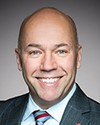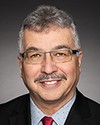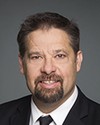Bonjour. Good afternoon, everyone.
Thank you very much to the members of this committee for giving me the opportunity to share my experience with you.
I want to quickly introduce myself. You've already heard my name, Cornelia Wieman. I'm originally a member of the Little Grand Rapids First Nation in Manitoba. I'm also a survivor of the sixties scoop. In 1998, I finished my training in psychiatry, and at that time I was the first woman to become an aboriginal psychiatrist in Canada.
The discussion that I hope we're going to have today will be partly based on my experience and the areas I've worked in over the past 20 years or so in the areas of mental health and health generally.
I spent eight years working as a psychiatrist in a community-based mental health clinic on the Six Nations of the Grand River territory. Then I moved to Toronto and spent about seven years in research at the University of Toronto. I co-directed the indigenous health research development program at the University of Toronto, and also the national Network for Aboriginal Mental Health Research, based out of McGill University.
From 2001 to 2002, I was a member of the suicide prevention advisory group. This is one of the key things I want to present to you with this afternoon. This was a group of individuals representing Canada nationally. We examined the issue of first nations youth suicide very comprehensively and released a report entitled “Acting On What We Know: Preventing Youth Suicide in First Nations”.
If you haven't seen a copy of that report, I can send the clerk the link to the pdf. It was a joint project between Health Canada's first nations and Inuit health branch and the Assembly of First Nations.
Since that time, I've moved back into the clinical realm. This time I have had quite a bit of experience working with urban aboriginal populations, mainly in Toronto, providing mental health services through the YWCA Elm Centre, which is a housing first model. This means that they will take women who are homeless or vulnerably housed, 50 aboriginal women suffering from mental health and addictions, and 100 other women who are not aboriginal. I was part of a mental health support team that worked with those women to try to improve their mental health but also maintain their housing in that building.
I've been working at the Centre for Addiction and Mental Health in Toronto since March of 2013. As part of our programming here at CAMH, we have an aboriginal services program. We serve people with mental health and/or addictions. We offer in-patient residential substance abuse treatment, outpatient substance abuse treatment, and outpatient psychiatric care.
In January of this year, I took a position at McMaster University one day a week to work as a faculty adviser to the aboriginal students health sciences program. The major goal of that program is to increase the number of aboriginal health professionals gaining entry into and graduating from McMaster University, which is very relevant to some of the recommendations from Canada's Truth and Reconciliation Commission that I've also included in my handout.
I know I have to be brief. I will talk mainly about the recommendations that came out of the suicide prevention advisory group, which were grouped into four major areas.
The first area was called “Putting Forward an Evidence-Based Approach to Prevention” of suicide. That advocated for continued support for research initiatives around the country, both in aboriginal communities and in partnership with aboriginal communities and academic institutions, such as universities, to increase what we know about indigenous suicide and work on solutions.
I know that previously at this committee, you heard a presentation from Alain Beaudet, who is the president of the Canadian Institutes of Health Research, and the Institute of Aboriginal Peoples' Health, whose scientific director is Malcolm King. I won't go into too much detail, except to say that when we talk about evidence-based approaches, we don't just mean a western framework for doing research. This can also include community-based initiatives and de-colonized approaches to understanding suicide. A lot of the time, there's difficulty obtaining funding for suicide research that communities want to do because, for whatever reason, it doesn't meet the academic standard that's put forward in a western framework.
The second major area was entitled “Toward Effective, Integrated Health Care at the National, Provincial and Regional Levels”. I suppose this is the area where I have the most experience. We need to learn about the best practices and models for delivering exemplary health care to aboriginal communities. I had the great fortune of working in the Six Nations of the Grand River, which you may or may not know is the largest first nations community in the country. When I worked there, it had a population of 11,000 to 12,000 people living on reserve, and almost the same number living off reserve.
I can't speak on behalf of the Six Nations community, but I do know that through the care that we delivered, our goal was always to try to provide services that would be equivalent to, or exceed, what someone would be able to obtain at a community mental health clinic in any urban or rural clinic, anywhere across the country. I believe we did that.
They have much more data on outcomes and things like that. I cannot speak to that because I don't work there anymore and they own their own data. I do know that, generally, people's outcomes were much better for being in contact with our service and being followed. We had lower rates of admission to hospital and lower rates of suicide than what you would expect when you look at first nation suicide rates across the country, which are generally thought to be two to four or five times the Canadian national average.
A major issue in mental health care is providing sustainable funding for mental health services and healing centres, on reserve, in rural areas, and in urban areas. Again, some of the recommendations from the Truth and Reconciliation Commission also speak to this.
For example, when you look at the budget for non-insured health benefits for the year 2013-14, the total expenditures for the entire budget were just over $1 billion. Pharmacare takes up 40.5% of that budget. There's a lot of money that's spent on pharmacare, as well as medical transportation to get people to and from their appointments. “Other health care” only accounts for 1.4% of that budget, which amounts to about $14.2 million. That other health care is deemed for short-term crisis intervention and mental health counselling benefits to address at-risk situations.
I know from checking the meeting schedule of this committee that you've already heard from the first nations and Inuit health branch. I believe you heard from Keith Conn around that.
There's been a long-standing issue of insufficient funding for both western-trained mental-health professionals, and traditional healing, which typically isn't reimbursed in the way that say, physicians, social workers, or psychologists are reimbursed. That, in itself, is an issue as well, because traditional healers spend a lot of time working with people in their communities, and a lot of the time, the work that they do is on a volunteer basis.
In its recommendations, the Truth and Reconciliation Commission also stressed the value of aboriginal traditional healing practices. Because I am aboriginal by background, I think I've had a natural tendency to be open to including traditional healing practices in the patients that I see, but other psychiatrists may not be.
That leads me into talking briefly about a health and human resources issue across the country. I checked the data from the Canadian Psychiatric Association. There are 4,770 psychiatrists across the country. I know of three other aboriginal psychiatrists who are practising in the country. There have been four of us for some time. I know of two aboriginal psychiatry residents who are in the process of completing their training, which brings us to a grand total of six. When you divide six by 4,770 you get 0.01%.
The reality is that virtually all psychiatric care across this country to aboriginal people is provided by non-aboriginal psychiatrists and other health professionals. I have questions about why we're training aboriginal family physicians, but why psychiatry, in and of itself, is seeming to be an unattractive specialty to attract aboriginal medical students to choose upon graduation.
In my work at McMaster in trying to recruit aboriginal students into the medical program, for example, we would really like to continue this pattern. Again, this is another major recommendation of the Truth and Reconciliation Commission. Because the majority of care is provided by non-aboriginal health professionals, there's a great need to train health professionals in cultural safety, so that they're providing culturally relevant care.
I'll end there and hope we have a really good discussion.
Thanks.








